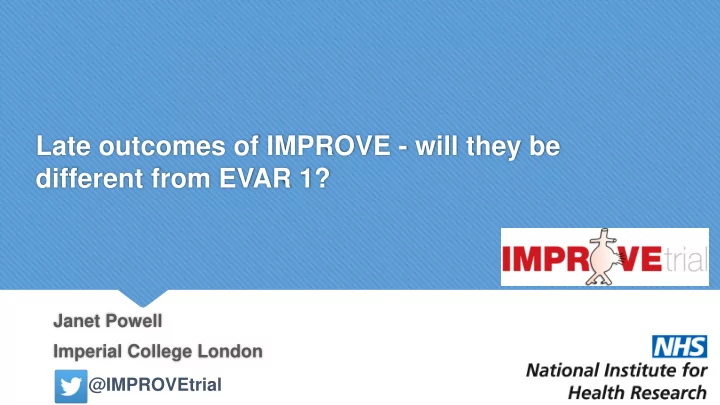

Late outcomes of IMPROVE - will they be different from EVAR 1? Janet Powell Imperial College London @IMPROVEtrial
3 questions to be addressed • Will EVAR for ruptures be associated with worse outcomes compared with open repair in late follow-up? • Why might they be different? • Will EVAR continue to be recommended in the management of ruptured AAA?
Differences between EVAR-1 & IMPROVE EVAR-1 IMPROVE Elective repair Emergency repair Selective recruitment All-comers Key question addressed Is early & mid-term survival Is early & mid-term survival better with EVAR vs open better with a 24/7 emergency repair EVAR service Patient age 74 years EVAR-2 77 years (patients unfit Sex (% male) 86 78 for open repair) AAA diameter/morphology 6.2 cm 8.4 cm 34% within IFU for EVAR unselected 5-year survival 74% 41%
Is AJAX a better comparator for EVAR-1? All patients within IFU for EVAR EVAR-1 AJAX Elective repair Emergency repair Key question addressed Is early & mid-term survival Is early & mid-term survival better with EVAR vs open better with EVAR vs open repair repair Patient age 74 years 74 years Sex (% male) 86 85 AAA diameter/morphology 6.2 cm 7.6 cm within IFU for EVAR within IFU for EVAR 5-year survival 74% 37%
Defining midterm by time untll <50% survival late outcomes beyond the <50% survival point Time to <50% survival EVAR-1 10 years elective repair in fit patients EVAR-2 4 years elective repair in those unfit for open repair IMPROVE or AJAX 4 years ruptured abdominal aortic aneurysm
Survival: primary o utcome Mid-term life year gain for EVAR strategy 100 3 year mortality OR [95%CI] P= 613 patients 0.73 [0.53 1.00] 0.053 Live 80 discharges 502 rupture repairs 0.62 [0.43, 0.89] 0.009 to home 56% 60 97% Endovascular strategy vs 40 48% 77% Open repair 20 Endovascular strategy Open repair 0 0 1 2 3 4 5 6 Years since randomisation Number at risk Endovascular strategy 259 161 154 148 108 50 21 BMJ 2017;359:j4859 Open repair 243 139 127 110 84 56 23
Cumulative incidence of re-interventions to 3 years: overall & clinician severity-rated Therefore overall costs remain slightly lower for endovascular strategy time to first re-intervention time to first re-intervention early renal support for life-threatening condition 30 25 32% 20 48% 20 Open repair 15 15 Endovascular strategy 10 10 5 5 0 0 0 1 2 3 0 1 2 3 Years since randomisation Years since randomisation Number at risk Endovascular strategy 259 146 132 121 Number at risk Open repair 243 125 111 92 Endovascular strategy 259 118 103 92 Endovascular strategy Open repair Open repair 243 114 96 78 Endovascular strategy Open repair
Endovascular strategy gains in quality of life: 0.17 QALYs at 3 years Gain probably increased at 4 years Limited 4y data 0.70 open repair 0.73 EVAR So, since costs are slightly lower for EQ-5D endovascular strategy group, this strategy is highly cost-effective
QALY benefit for EVAR strategy highest in women, Incremental net benefit [95% CI] (£ GBP) within 3-years of shortish necks & most unstable patients randomisation, by subgroups, at £30,000 per QALY Increment Incremental Incremental al net Subgroup cost p- QALY benefit £ value £ Male (N=480) -3883 0.084 6401 p= Sex Female (N=133) 2817 0.339 7354 0.460 Hardman=0 (N=164) -3725 0.150 8228 p= Hardman=1 (N=254) -2198 -0.015 1747 Hardman Index 0.253 Hardman≥2 (N=121) -1199 0.436 14291 Length < 22 (N=234) -1215 0.209 8495 AAA Neck length p= Length ≥ 22 (N=247) (mm) -3578 0.092 6339 0.496 SBP < 90 (N=263) -4709 0.067 7706 p= Lowest SBP (mm Hg) SBP ≥ 90 (N=305) -466 0.193 6249 0.446
Cost-effectiveness driven by QALY gains No indications that QALY gain is attenuated at 4 years QALY gains for the EVAR strategy tend to be higher in women, those with shorter AAA necks (<22 mm) and the most unstable patients unselective recruitment design of IMPROVE illuminated these findings and helped show that overall the EVAR strategy was cost- effective for ruptured AAA at 3 years & is likely to remain so Unselective recruitment means generalisability
EVAR strategy has key benefits for patients with rupture at all time points Getting patients home quickly with no disability Better quality of life, especially in first year Lower rates of amputation & open stoma Better mid-term survival Recommended by NICE
Mid-term* comparison of IMPROVE versus EVAR 1: an EVAR strategy stays good for ruptures *point until <50% survival Outcome IMPROVE (4y) EVAR-1 (4 or 10y) Survival EVAR strategy better No difference Quality of life EVAR strategy better No difference QALY s EVAR strategy better No difference Re-interventions No difference EVAR higher Costs EVAR strategy lower EVAR higher Cost-effectiveness EVAR strategy better Open repair better Generalisability Good Limited The winner EVAR strategy Open repair ???
Recommend
More recommend